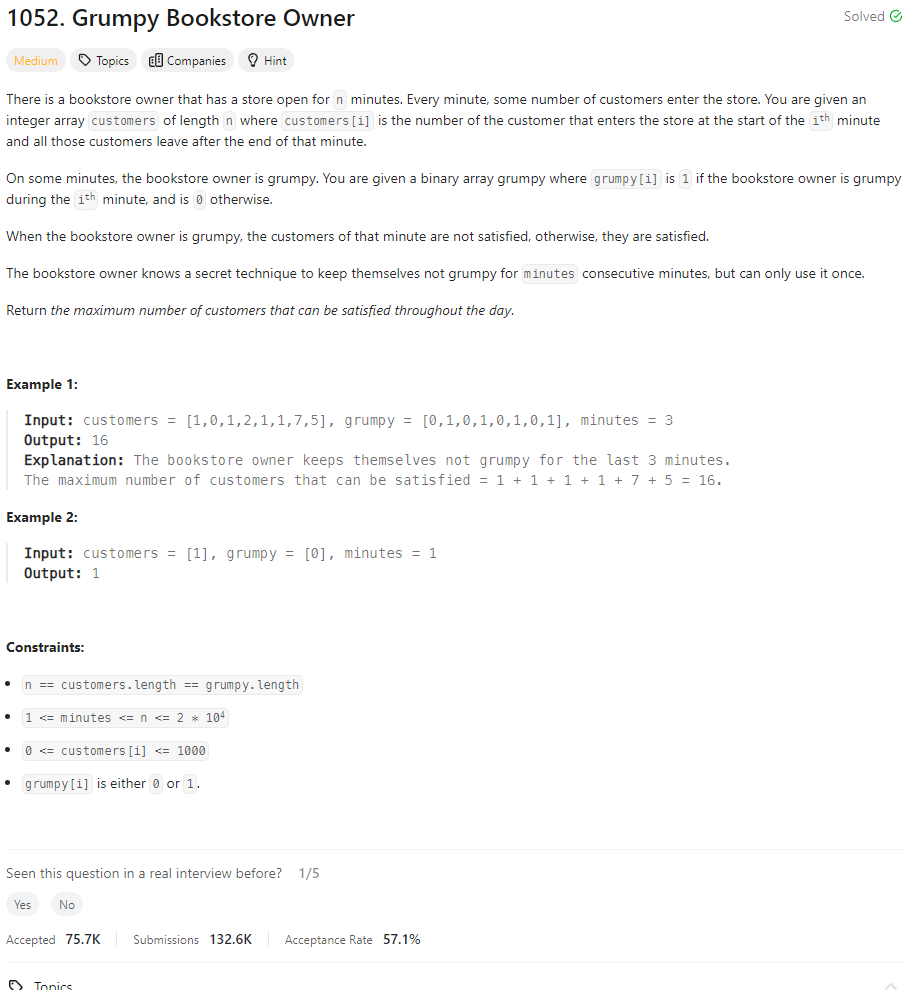Problem of The Day: Grumpy Bookstore Owner
Problem Statement

Intuition
My first thought on how to solve this problem is to maximize the number of satisfied customers by leveraging the non-grumpy minutes effectively. By using a sliding window approach, I can calculate the potential satisfaction increase within any minutes window, while maintaining the base satisfaction from non-grumpy customers.
Approach
- Calculate the total number of satisfied customers without any intervention, which includes only the customers when the owner is not grumpy.
- Use a sliding window of size
minutesto find the maximum increase in satisfaction by turning the grumpy owner non-grumpy for that window duration. - The result will be the sum of the always satisfied customers and the maximum possible additional satisfied customers from the best window.
Complexity
- Time complexity: The time complexity of this approach is (O(n)), where (n) is the number of customers. This is because we only need to pass through the list a couple of times.
- Space complexity: The space complexity is (O(1)) since we only use a few extra variables regardless of the input size.
Code
class Solution:
def maxSatisfied(self, customers: List[int], grumpy: List[int], minutes: int) -> int:
n = len(customers)
max_sum = 0
total_satisfied = sum(customers[i] for i in range(n) if grumpy[i] == 0)
for i in range(n - minutes + 1):
curr_sum = sum(customers[i:i+minutes])
curr_satisfied = sum(customers[i] for i in range(i, i + minutes) if grumpy[i] == 0)
curr_sum += total_satisfied - curr_satisfied
if curr_sum > max_sum:
max_sum = curr_sum
return max_sum
Editorial
class Solution:
def maxSatisfied(
self, customers: List[int], grumpy: List[int], minutes: int
) -> int:
n = len(customers)
unrealized_customers = 0
# Calculate initial number of unrealized customers in first 'minutes' window
for i in range(minutes):
unrealized_customers += customers[i] * grumpy[i]
max_unrealized_customers = unrealized_customers
# Slide the 'minutes' window across the rest of the customers array
for i in range(minutes, n):
# Add current minute's unsatisfied customers if the owner is grumpy
# and remove the customers that are out of the current window
unrealized_customers += customers[i] * grumpy[i]
unrealized_customers -= customers[i - minutes] * grumpy[i - minutes]
# Update the maximum unrealized customers
max_unrealized_customers = max(
max_unrealized_customers, unrealized_customers
)
# Start with maximum possible satisfied customers due to secret technique
total_customers = max_unrealized_customers
# Add the satisfied customers during non-grumpy minutes
for i in range(n):
total_customers += customers[i] * (1 - grumpy[i])
# Return the maximum number of satisfied customers
return total_customers